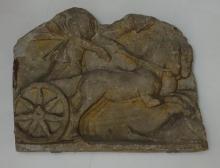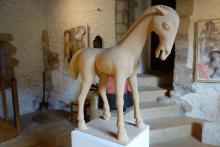Statement of intent: This podcast explores the symbolism of the horse in troubadour poems, ancient sculptures, and modern art forms.
In this first podcast, we looked into the symbolism of the horse in various troubadours’ poetry by referencing ancient Roman and Greek art, bestiaries, modern sculptures, and modern music interpretations of troubadour lyrics. In Roman and Greek art exhibited in the archaeology museum in Narbonne, horses are almost always depicted as soldiers’ companions in war (see figure 1 for Roman sculpture of war chariot, and figure 2 for modern representation of Greek warrior horse), and ancient Roman cities are designed specifically with the frequent use of horses and chariots in mind. Ancient bestiaries, such as the one written by Isidore of Seville in 7th century CE, indicate that horses are the only animals that are naturally drawn towards war and respond to war trumpets and battle cries, explaining why many troubadours use horses to describe the act of going into battle and of doing work. Bertran de Born, a troubadour whose love of war is widely known, often uses the imagery of the horse to validate the valiance of a lord or the violence of a battle. Guillaume IX, in his poem Farai un vers de dreyt nien (Goldin, 24), writes a poem about riding his horse while doing nothing – an act of defiance against his duties as a lord – and uses his horse to simultaneously represent both duty and his rejection of duty. Because of their association with lords and knights, horses were also connected with images of chivalry and loyalty. According to the Pliny the Elder in his bestiary from 1st century CE, horses are extremely faithful to their masters and are known to grieve when their masters die. This ties in effortlessly with the idea of paratge, a concept that encompasses honor, courtesy, nobility, and gentility often explored in troubadour poetries.
While horses represent war and nobility to some troubadours, others often used them as a metaphor for women or sexual conquests. The act of riding a horse has obvious similarities to the act of sexual intercourse, as exploited in Guillaume IX’s poem Companho, faray un vers…convinen, in which he writes about two women as “two good and noble horses for [his] saddle” (Goldin, 21). Marcabru, in his poem L’autrier jost’una sebissa, evokes a horse-riding imagery when he writes about a knight seducing a shepherd girl by saying that she “would be twice as beautiful / if once [he] saw [her] / underneath and [him] on top” (Goldin, 75). An interesting point can be noted that while troubadour poetry hails fin’amor and places the domna on a perfect pedestal, troubadours still prize the imagery of riding a woman and having the woman physically, and perhaps also metaphorically, beneath them.
All three symbols of the horse presented above can be combined with the idea of horse as a representation of rhythm. Firstly, horses respond to the rhythm of battle cries, which explains their symbolism of war and power. Moreover, horses’ hoof beats carry a characteristic, ordered rhythm that corresponds well with the order of chivalrous society and the ordered relationships between lords and their vassals. Finally, the rhythmic vertical bounces while riding a horse are reflected in the rhythmic movement of sexual intercourse, transforming the act of horse riding into a distinctive euphemism for sexual escapades, and horses into a metaphor for sexual prowess and conquests. This focus on rhythm in relation to horses is highlighted in Gerard Zuchetto’s interpretation of Guillaume IX’s poem Farai un vers de dreyt nien, referenced earlier, in which the rhythmic tapping of the drum and the recitation of the poem mimic the ordered hoof beats of horses on the road. Zuchetto’s interpretation seamlessly ties together all the symbolisms that the horse carries in various forms of art and literature during the troubadour period.
Horse symbolism in troubadour poetry (podcast)
Submitted by Stephanie Wing ... on Tue, 07/22/2014 - 00:00
Course:
The Other France: Troubadours and the Politics of Cultural Heritage
File upload:
Project type:


